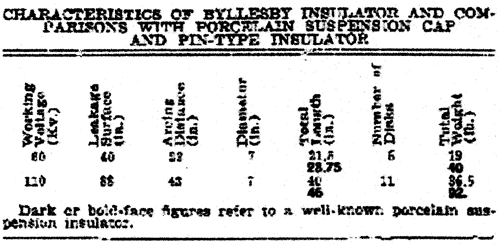[Trade Journal]
Publication: Electrical World
New York, NY, United States
vol. 69, no. 16, p. 745, col. 1-2
CHARACTERISTICS OF GLASS
MICARTA-CORE INSULATOR
Results Obtained with High-Voltage Insulator
Developed to Overcome Inherent Faults
of Porcelain Insulators
BY LINCOLN NISSLEY
During the last two years the engineering department of H. M. Byllesby & Company has made an extensive investigation of insulator problems with a view toward producing a better insulator than the present market affords at the same cost, and to using materials which do not have the inherent defects that porcelain is known to have. The possibility of producing the insulators in quantities without delay was also considered, since insulator manufacturers at present are unable fully to meet demands and make prompt deliveries.
In designing the Byllesby insulator careful study was made of first principles and their application, fundamental laws of mechanics and materials, electrostatic and magnetic laws, and economic principles. Electrical and mechanical tests made upon the insulator which was finally developed indicate that the principles were correctly applied. This indication is strengthened by a year of successful operation and the experience gained in the assembly of more than 15,000 units, not a single one of which has failed to date.
 |
| Section — Elevation Micarta-Core Glass Insulator |
The insulator consists of a micarta core on which are assembled glass disks separated by asbestos washers and held in place by a simple interlocking washer and cotter key. Castings are fastened to each end of the core for attaching it to the support and conductor. After the parts are in place the unit is heated uniformly to a temperature of 100 deg. Fahr. and compound poured into the core through the top casting. Thus only the end castings and micarta core are subjected to mechanical stress, the disks being required only to increase the leakage surface and arc-over distance. The compound poured into the core is employed principally to prevent moisture entering the insulator shell, but also serves to prevent puncture from power arc. Corresponding parts of these insulators, regardless of size, are interchangeable. An additional advantage of the insulator is its relatively light weight, which permits economy in freightage, cartage and labor and reduces dead-load on the tower supports. Some of the principle characteristics of the Byllesby insulator are given in the accompanying table with the dimensions and weight of a well-known porcelain suspension cap and pin-type insulator.
From a number of tests made on the 11-disk insulators it has been found that they do not arc over when dry until 310 kv. has been impressed. When wet 240 kv. is necessary. Subjected to high-frequency oscillations from a machine capable of developing 600 kv. at 100,000 cycles, this type of insulator successfully withstood 200 kv. for one-half minute and 300 kv. for one minute. The voltage was gradually increased over a period of five minutes to 550 kv., when the insulator arced over. It is interesting to note that when these insulators do flash over the arc curves outward; thus the disks are less liable to destruction.
 |
During tests that have been carried to the point of destruction the top casting and lower clamps were melted and destroyed and two of the end disks melted but the micarta core and central group of disks were uninjured. In this condition the insulator withstood 290 kv. before arcing over. From this experience it appears that the micarta core alone would answer all operating requirements during fair weather. To test the value of the compound the insulators have been submerged in solutions of soda and other lyes for twenty-four hours and while still dripping have been subjected to 200 kv. before arcing over.
The eleven-disk insulators will be used exclusively on the 110,000-volt line which is being built from Wisconsin to Minneapolis to serve the Twin Cities. The line west of Stillwater is being equipped with them. Five-disk insulators of the micarta-core glass-disk type are also being placed on a number of 60,000-volt lines in various parts of Minnesota. The Montana Power Company was one of the first companies to try out the glass disk feature.
